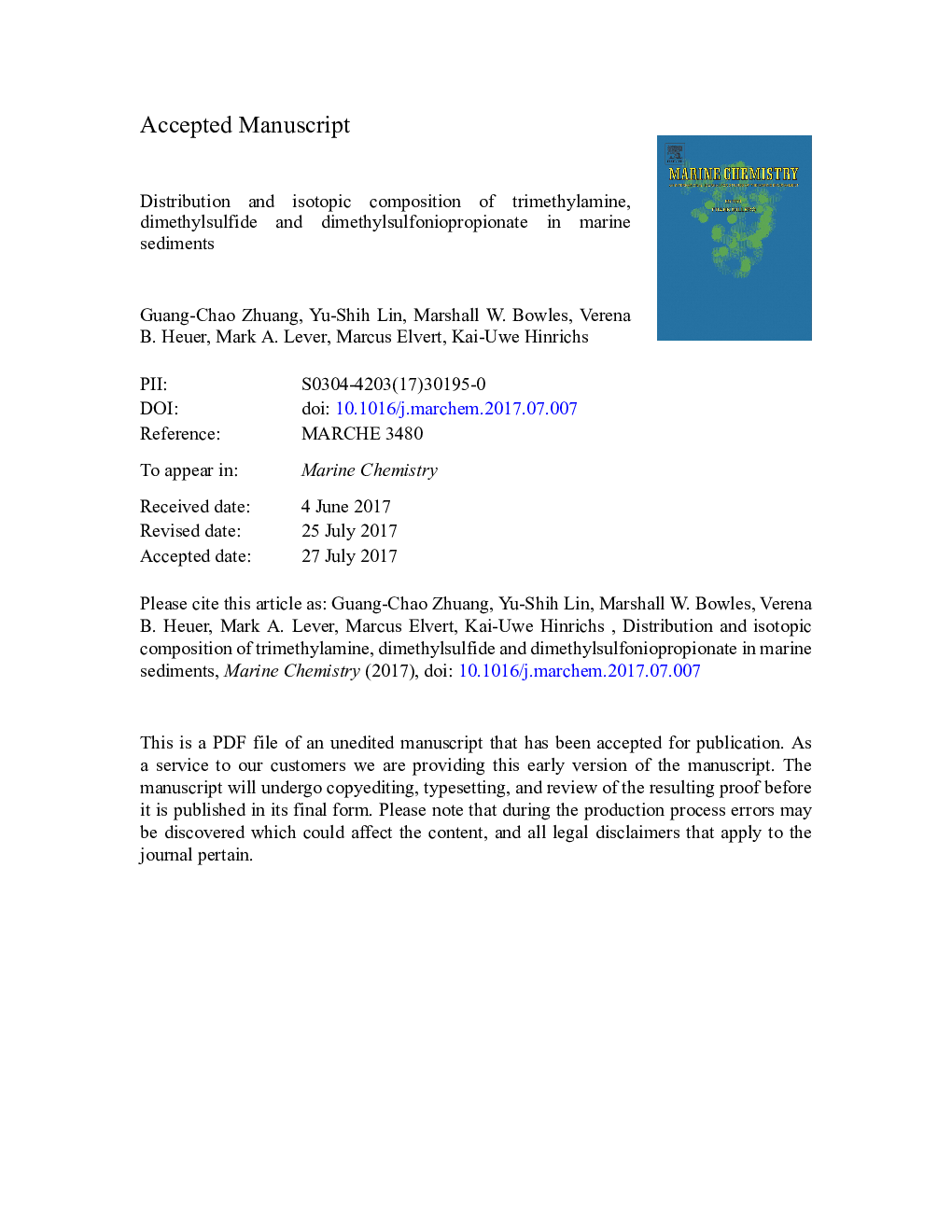| کد مقاله | کد نشریه | سال انتشار | مقاله انگلیسی | نسخه تمام متن |
|---|---|---|---|---|
| 7698984 | 1496640 | 2017 | 50 صفحه PDF | دانلود رایگان |
عنوان انگلیسی مقاله ISI
Distribution and isotopic composition of trimethylamine, dimethylsulfide and dimethylsulfoniopropionate in marine sediments
ترجمه فارسی عنوان
توزیع و ترکیب ایزوتوپهای ترتی الیامین، دی متیل سولفید و دی متیل سولفونی پروپوونات در رسوبات دریایی
دانلود مقاله + سفارش ترجمه
دانلود مقاله ISI انگلیسی
رایگان برای ایرانیان
کلمات کلیدی
موضوعات مرتبط
مهندسی و علوم پایه
شیمی
شیمی (عمومی)
چکیده انگلیسی
Methylated amines and sulfides are ubiquitous organic nitrogen and sulfur compounds in the marine environment and could serve as important energy substrates to methanogens inhabiting anoxic sediments. However, their abundance and isotopic values remain largely unconstrained in marine sediments. In this study, we investigated the distribution of trimethylamine (TMA), dimethylsulfide (DMS) and dimethylsulfoniopropionate (DMSP) in Aarhus Bay, Denmark and provided the first report for their stable carbon isotopic composition. Simultaneous measurement of those two compounds in small volumes of pore waters and sediments was accomplished with gas chromatography in combination with either a purge and trap system for quantification or a headspace method for carbon isotopic analysis. TMA in the solid phase (exchangeable pool, 0.3-6.6 μmol kgâ1 wet sediment; base-extractable pool, 2-18 μmol kgâ1) was much more abundant than the dissolved pool (< 20 nM), indicating strong adsorption of TMA to sediments. Likewise, total base-hydrolyzable DMS(P)t (including DMS and base-released DMS from DMSP) in sediment was at least three orders of magnitude higher (11-65 μmol kgâ1) than the dissolved pool of DMS(P)d in the pore water (including DMS and dissolved DMSP; 1-12 nM). TMA and DMS(P) contents in the solid phase peaked in the surface sediment, consistent with their phytodetrital origin. TMA was more 13C-depleted than DMS(P) (TMA: â36.4â° to â39.2â°; DMS: â18.6â° to â23.4â°), presumably due to different biological or biosynthetic origins of the respective methyl groups. Both compounds showed a downcore decrease in their solid-phase concentration, a feature that was attributed to microbial degradation, but progressive enrichment in 13C (up to 4â°) with depth was observed only for DMS(P). The considerable pool size of TMA and DMS(P) outlined in this study and geochemical evidence of their degradability suggested these two compounds could be potentially important substrates for methane production in sulfate-reducing environments.
ناشر
Database: Elsevier - ScienceDirect (ساینس دایرکت)
Journal: Marine Chemistry - Volume 196, 20 November 2017, Pages 35-46
Journal: Marine Chemistry - Volume 196, 20 November 2017, Pages 35-46
نویسندگان
Guang-Chao Zhuang, Yu-Shih Lin, Marshall W. Bowles, Verena B. Heuer, Mark A. Lever, Marcus Elvert, Kai-Uwe Hinrichs,
